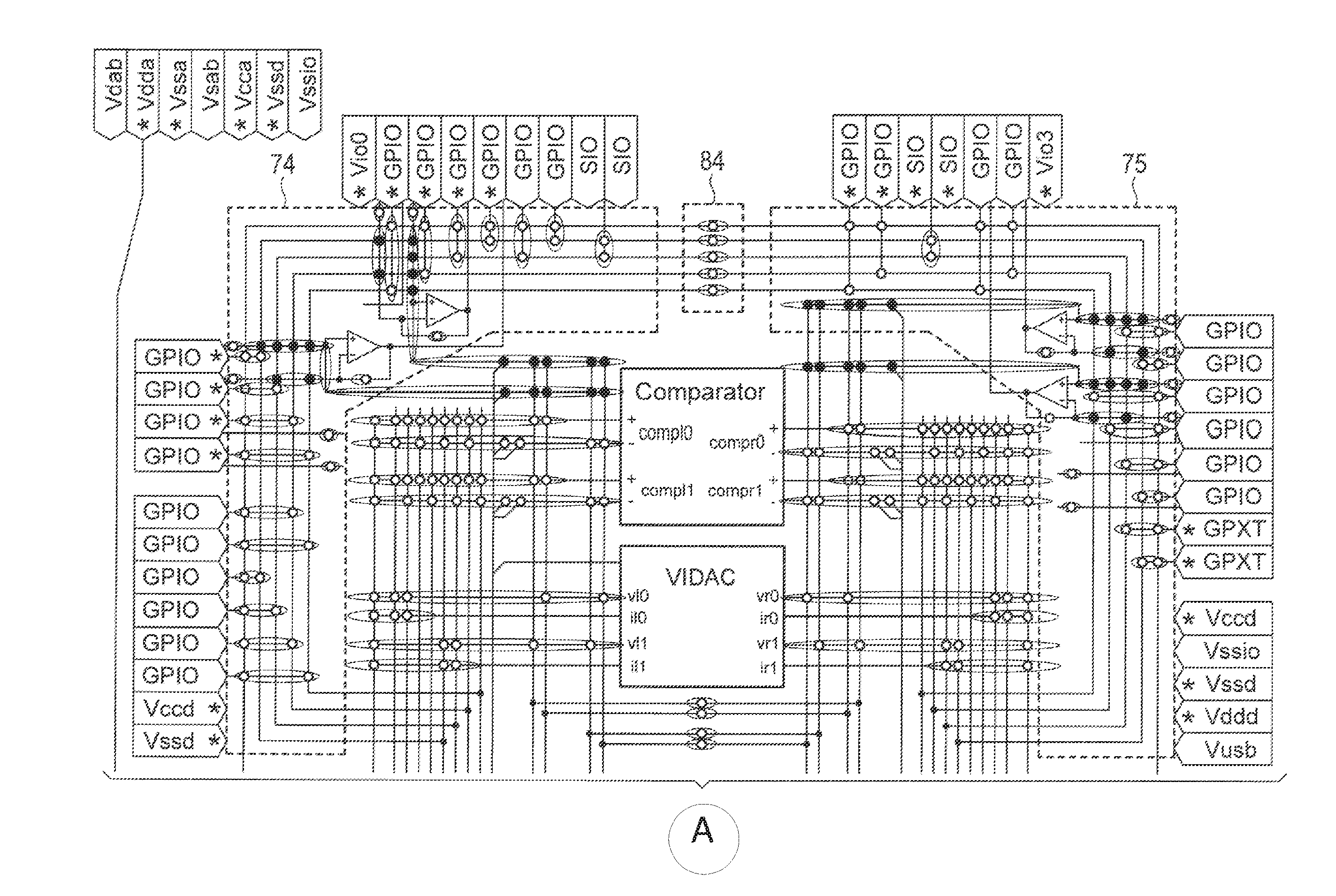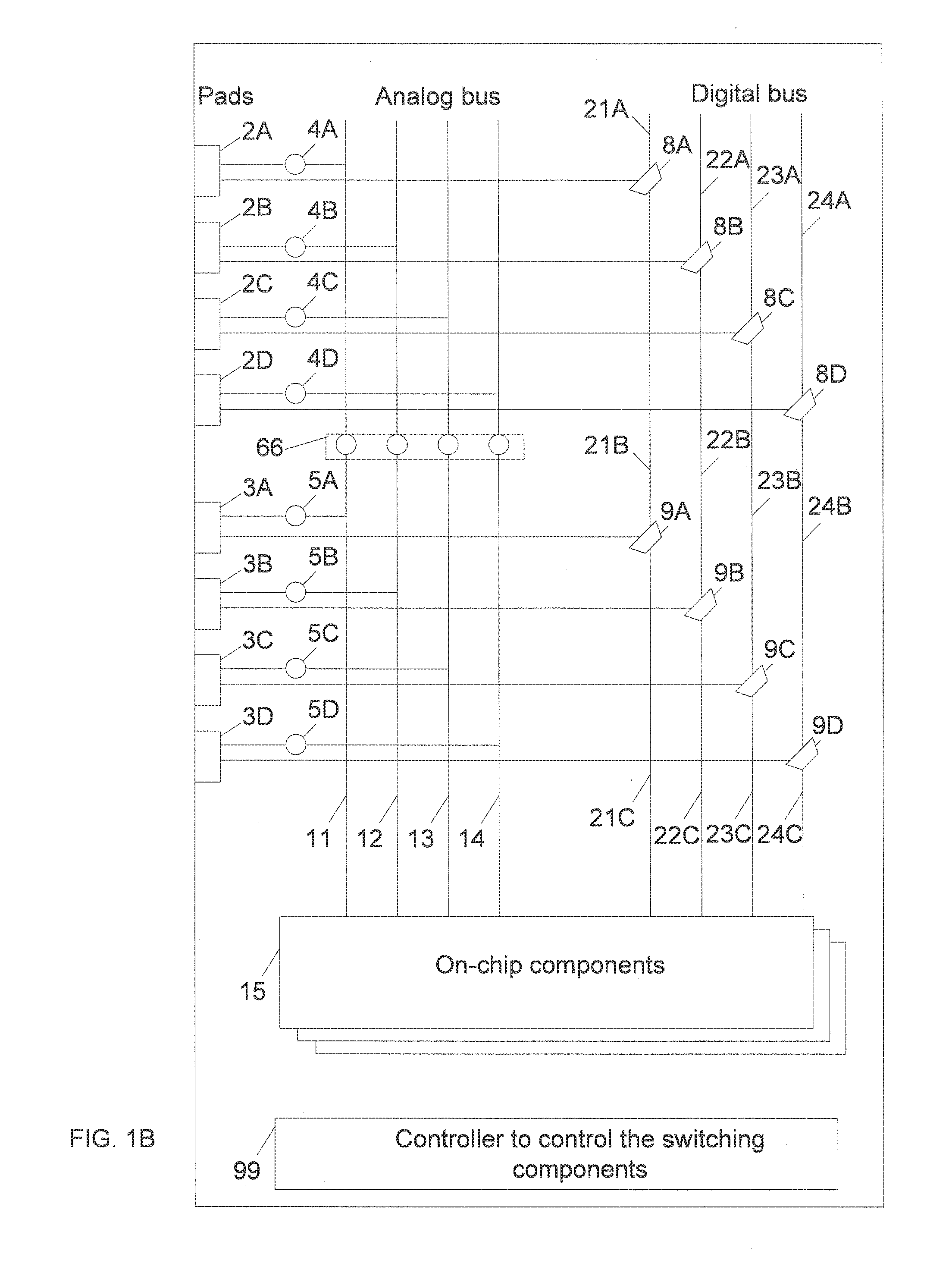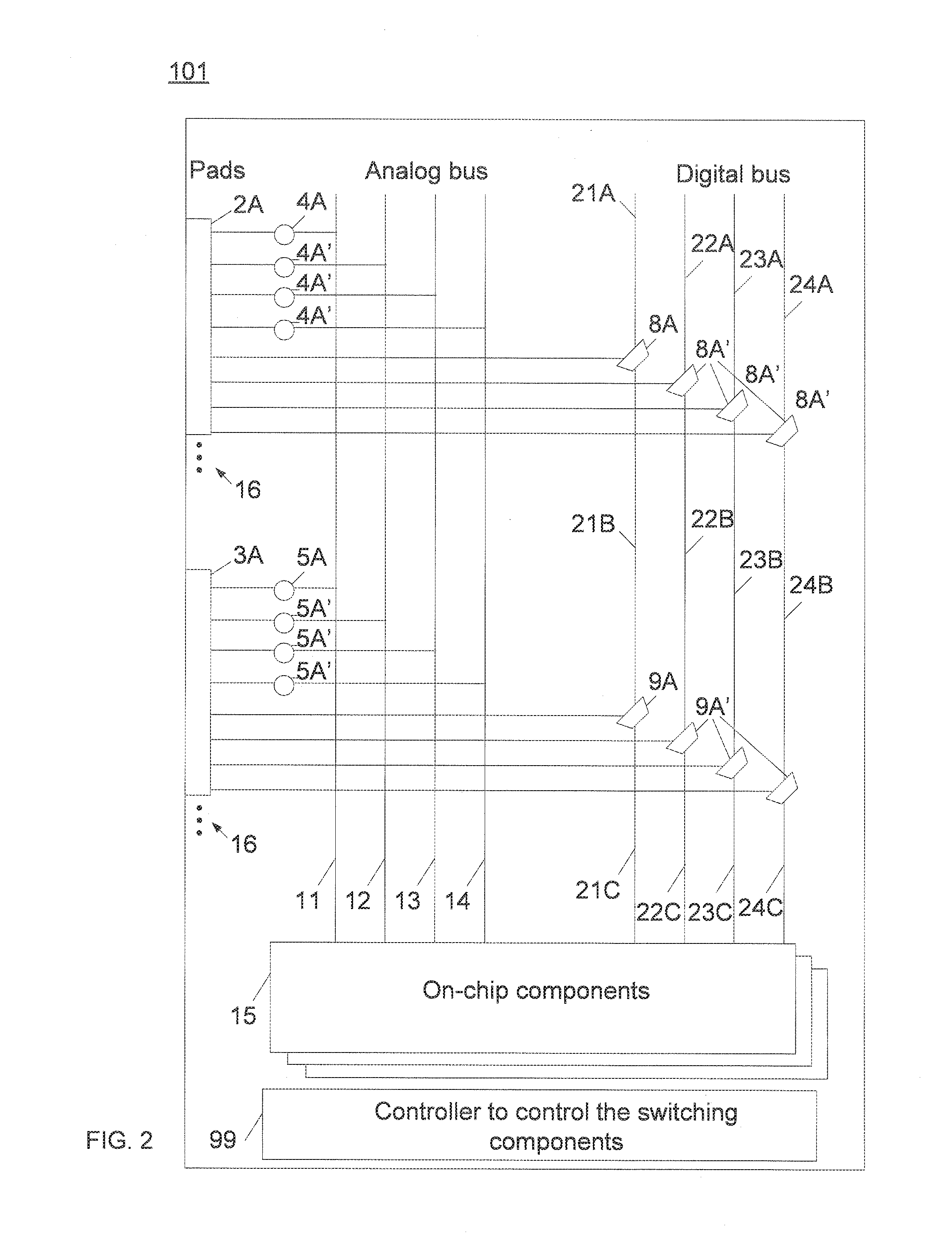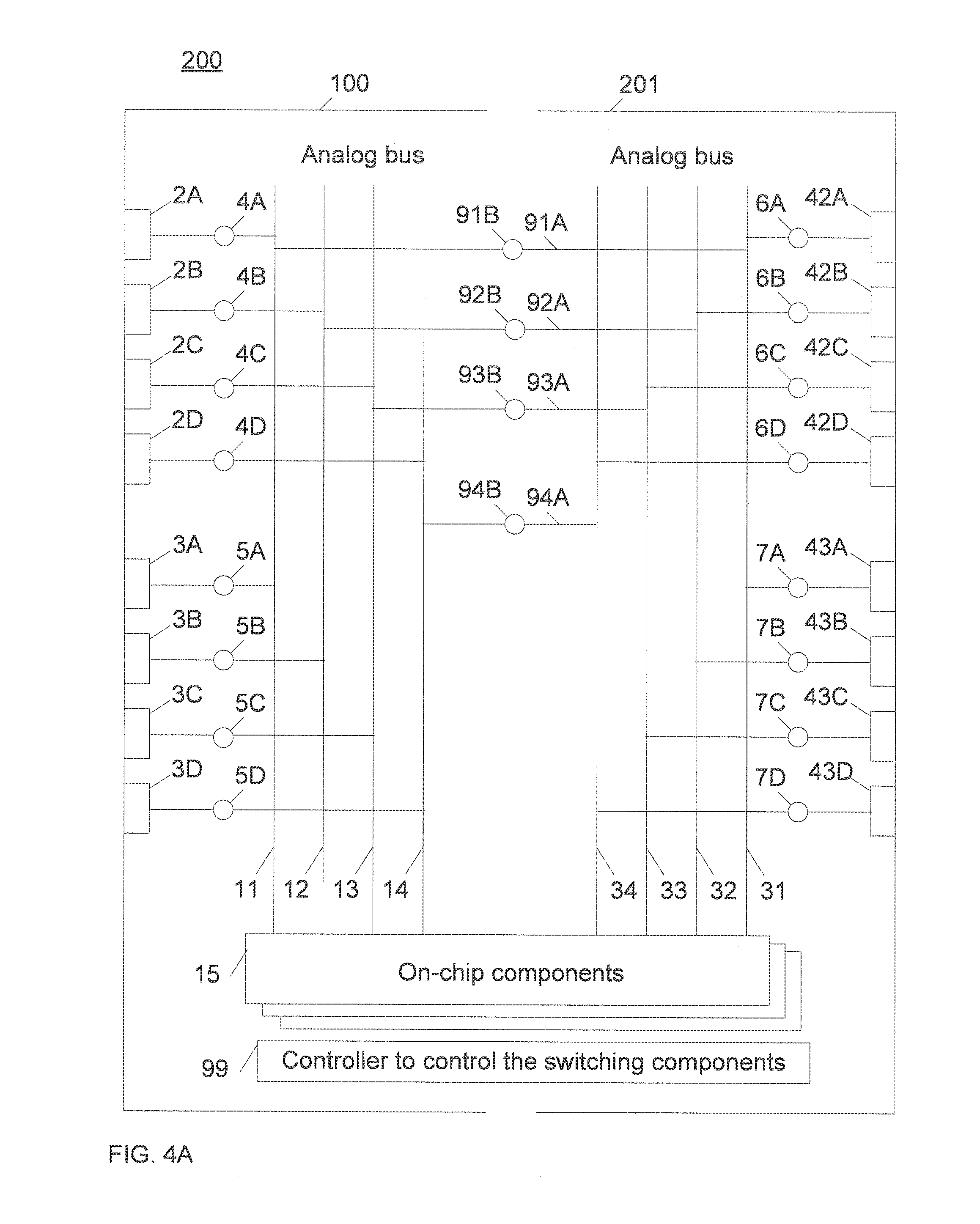Bus Sharing Scheme
Williams; Timothy John ; et al.
U.S. patent application number 15/647077 was filed with the patent office on 2017-12-28 for bus sharing scheme. This patent application is currently assigned to Cypress Semiconductor Corporation. The applicant listed for this patent is Cypress Semiconductor Corporation. Invention is credited to Mark E Hastings, Harold M. Kutz, Warren S. Snyder, Eashwar Thiagarajan, Timothy John Williams, David G. Wright.
| Application Number | 20170371824 15/647077 |
| Document ID | / |
| Family ID | 48225461 |
| Filed Date | 2017-12-28 |











| United States Patent Application | 20170371824 |
| Kind Code | A1 |
| Williams; Timothy John ; et al. | December 28, 2017 |
BUS SHARING SCHEME
Abstract
A programmable device, having an analog component coupled with an analog bus and a digital component coupled with a digital bus together with a set of 10 pads, each of which capable of being coupled to a bus line of one segment of the analog bus as well as to at least one digital bus line, and where the analog bus is capable of being used to connect a pair of the pads to each other.
| Inventors: | Williams; Timothy John; (Bellevue, WA) ; Wright; David G.; (Woodinville, WA) ; Kutz; Harold M.; (Edmonds, WA) ; Thiagarajan; Eashwar; (Bothell, WA) ; Snyder; Warren S.; (Snohomish, WA) ; Hastings; Mark E; (Mukilteo, WA) | ||||||||||
| Applicant: |
|
||||||||||
|---|---|---|---|---|---|---|---|---|---|---|---|
| Assignee: | Cypress Semiconductor
Corporation San Jose CA |
||||||||||
| Family ID: | 48225461 | ||||||||||
| Appl. No.: | 15/647077 | ||||||||||
| Filed: | July 11, 2017 |
Related U.S. Patent Documents
| Application Number | Filing Date | Patent Number | ||
|---|---|---|---|---|
| 14540238 | Nov 13, 2014 | 9720865 | ||
| 15647077 | ||||
| 13893201 | May 13, 2013 | 8890600 | ||
| 14540238 | ||||
| 12496579 | Jul 1, 2009 | 8441298 | ||
| 13893201 | ||||
| 61077466 | Jul 1, 2008 | |||
| Current U.S. Class: | 1/1 |
| Current CPC Class: | H03K 19/1732 20130101; G06F 13/4022 20130101 |
| International Class: | G06F 13/40 20060101 G06F013/40 |
Claims
1-20. (canceled)
21. A circuit comprising: a plurality of configurable components; a routing fabric coupled to the plurality of configurable components; a plurality of GPIO pads coupled to the routing fabric, the routing fabric for coupling at least two of the configurable components and at least one of the plurality of GPIO pads; and control circuit to define a configuration of the routing fabric.
22. The circuit of claim 21, wherein the plurality of configurable components comprises at least one digital component and at least one analog component.
23. The circuit of claim 21, wherein the at least one digital component and the at least one analog component are programmable.
24. The circuit of claim 21, further comprising at least one fixed-function component.
25. The circuit of claim 21 further comprising a central processing unit coupled to the routing fabric.
Description
CROSS-REFERENCE TO RELATED APPLICATIONS
[0001] This Application is a Continuation of U.S. patent application Ser. No. 14/540,238, filed on Nov. 13, 2014, which is a Continuation of U.S. patent application Ser. No. 13/893,201, filed May 13, 2013, now U.S. Pat. No. 8,890,600, issued on Nov. 18, 2014, which is a continuation of U.S. patent application Ser. No. 12/496,579, filed Jul. 1, 2009, now U.S. Pat. No. 8,441,298, issued May 14, 2013, which claims priority to U.S. Provisional Patent Application No. 61/077,466, filed Jul. 1, 2008, all of which are incorporated by reference herein in their entirety.
TECHNICAL FIELD
[0002] This disclosure relates generally to analog circuits, and more particularly to sharing buses in the analog domain.
BACKGROUND
[0003] Buses having a plurality of lines connect circuit components to each other, as well as to input and output ports. Utilizing one line for each possible interconnection can result in a great number of lines. Each line consumes device space, i.e., real estate, both for the line itself and for spacing around the line.
SUMMARY
[0004] The following is a summary of embodiments of the invention in order to provide a basic understanding of some aspects. This summary is not intended to identify key/critical elements of the embodiments or to delineate the scope of the embodiments. Its sole purpose is to present some concepts in a simplified form as a prelude to the more detailed description that is presented later.
[0005] In one example, transmission gates selectively connect a plurality of General Purpose Input Output (GPIO) pads to a bus line of an analog bus. Alternating selective connections between the transmission gates allows the GPIO pads to share the bus line, saving real estate in an embodiment. The transmission gates may also be controlled in other ways to provide dynamic configuration of the circuit, such as connecting the GPIO pads to each other over the bus line.
BRIEF DESCRIPTION OF THE DRAWINGS
[0006] FIG. 1A shows a system utilizing a plurality of switches to share analog lines between I/O ports in an embodiment.
[0007] FIG. 1B shows a variation of the system of FIG. 1A utilizing a plurality of switches to share analog and digital lines between I/O ports in an embodiment.
[0008] FIG. 1C illustrates examples of the switching components located on the analog lines of the system shown in FIGS. 1A and 1B in an embodiment.
[0009] FIG. 1D illustrates an alternative example of the switching component located on the digital lines of the system shown in FIG. 1B in an embodiment.
[0010] FIG. 2 shows a system similar to the system shown in FIG. 1A but having additional switching components in an embodiment.
[0011] FIG. 3 shows a system utilizing a plurality of bus networks in an electronic device in an embodiment.
[0012] FIG. 4A shows a system similar to the system shown in FIG. 3 but having additional switching components in an embodiment.
[0013] FIG. 4B shows a variation of the system of FIG. 4A in an embodiment.
[0014] FIGS. 5A and 5B (collectively referred to as "FIG. 5" hereinafter) show partial views that together form a single complete view that shows an example circuit utilizing a bus sharing scheme in an embodiment.
DETAILED DESCRIPTION OF EXAMPLE EMBODIMENTS
[0015] Several examples of the present application will now be described with reference to the accompanying drawings. Various other examples of the invention are also possible and practical. This application may be exemplified in many different forms and should not be construed as being limited to the examples set forth herein.
[0016] FIG. 1A shows a system 100 utilizing a plurality of switches to share analog lines between I/O ports in an embodiment.
[0017] Unlike some circuits where there is a one-to-one correspondence between bus lines and General Purpose Input/Output (GPIO) ports, the example system 100 has a plurality of GPIO pads selectively connected to each bus line. For example, the pads 2A and 3A are both selectively connected to bus line 11 via transmission gates 4A and 5A respectively. It is noted that the bus lines can be connected to analog components such as, but not limited to, ADCs, DACs, comparators, etc.
[0018] It should be appreciated that the above-described concept may save real estate. For example, in another system with eight GPIO pads, eight bus lines are specified. In the present example, four bus lines are used for the eight GPIO pads 2A-2D and 3A-D due to the switching scheme. For example, bus line 11 can be used by either of the pads 2A or 3A, at any given time.
[0019] In an embodiment, one bus line is connected to multiple ports simultaneously. For example, both switches 4A and 5A can be closed at the same time to connect bus line 11 to both pads 2A and 3A.
[0020] Alternatively, both pads 2A and 3A can be simultaneously opened to disconnect both of these pads 2A and 3A. This could be used to free up the bus line 11 to send signals between internal components 15 (either analog or digital or both) that are also selectively connected to the bus line 11. In other words, the bus line 11 is not only shared between I/O ports, but also can be shared with internal components 15 using the switching scheme.
[0021] The switching scheme described above can be further extended by adding additional switching components along the bus lines 11-14 themselves. For example, switches can be added at the dashed box 66. These switches, if added, break each of the bus lines 11-14 into sub bus lines that can be combined by closing a respective one of the switching components of dashed box 66. Such switches could allow, for example, pads 2A and 3A to connect to different sub bus lines at one time, but connect to each other through joined sub bus lines at another time.
[0022] It should be understood that the transmission gates 4A-D and 5A-5D can be controlled in any known fashion. For example, registers could be arranged for each gate and set or unset according to a request (whether generated by a user or an internal component). Or in other examples, an internal logic function controls the transmission gates. Or in another example, some portion of the transmission gates may be controlled by the internal logic while another portion is controlled according to register settings. In any case, the transmission gates may be controlled by a controller, and here controller 99 may be operating all the switching components (namely in this example switching components 4A-4D and 5A-5D) to share access to the bus lines (and provide pad interconnections and internal component interconnections as needed).
[0023] In the present example, the I/O ports 2A-2D and 3A-3D are general purpose I/O ports. In other examples, any I/O ports can be used. Furthermore, the principles described above can be applied independently of I/O ports. For example, on-chip circuit components can be connected to the bus lines and the bus lines may or may not also connect to I/O ports.
[0024] Although the bus lines 11-14 are referred to as "analog" bus lines, meaning that these bus lines have transmission characteristics selected for analog transmissions, in some examples digital signals may be sent in through the pads. For example, a digital signal may be sent over one of the pads to an internal DAC, and then sent back as an analog signal over the same or another one of the bus lines 11-14 to a different pad, for example.
[0025] As discussed in greater detail in co-pending U.S. patent application Ser. No. 12/496,590, entitled "Multifunction Input/Output Circuit", which is herein incorporated by reference in its entirety, a multifunction I/O interface cell and controller can allow an I/O pad to be used for multiple purposes depending on the settings of the controller. It should be appreciated that each of the I/O pads described herein can be selectively connected to their respective bus lines through the multifunction I/O interface cell to expand configurability.
[0026] FIG. 1B shows a variation of the system of FIG. 1A utilizing a plurality of switches to share analog and digital bus lines between I/O ports in an embodiment.
[0027] The variant system of FIG. 1B utilizes logic gates 8A-D and 9A-D to selectively connect the pads 2A-D and 3A-D to each other and internal digital components via digital bus lines 21A-C, 22A-C, 23A-C, and 24A-C. In the present example, the logic gates 8A-D and 9A-D are multiplexers, although in other examples different types of logic gates may be used.
[0028] The two-to-one multiplexer 8A receives inputs including the connection extending to pad 2A and the digital bus line 21A. The multiplexer 8A output is connected to digital bus line 21B, which could then be directly connected to an internal digital component (or even selectively connected to one of a plurality of digital components). The same digital bus line 21B is then fed into an input of the multiplexer 9A, as shown.
[0029] Similar to the previously discussed dashed box 66, the digital side may be modified to include logic gates along the bus lines 21B, 22B, 23B, and 24B. Such logic gates could be tri-state drivers, instead of the two-to-one multiplexers.
[0030] FIG. 1C illustrates examples of the switching components located on the bus lines of the system shown in FIGS. 1A and 1B in an embodiment.
[0031] The transmission gates 4A-D and 5A-D shown in FIG. 1A may be of any type. One possible type of transmission gate is the NMOS transistor of FIG. 1C. The type of transmission gate may be selected based on the expected characteristics of the signals to be connected to the pad 2A.
[0032] If the different signals that may be connected to the pad 2A have a wide range of operating characteristics, then transmission gates connected in parallel for the switching components may be utilized. For example, if the pad 2A may provide high or low voltage signals depending on register settings, the switching component selectively connecting the pad 2A to the bus line 11 may be an NMOS and PMOS transistor connected in parallel. This concept may be extended to add additional transistor types in parallel according to the characteristics of the signals received over I/O pads.
[0033] FIG. 1D illustrates an alternative example of the switching component located on the digital bus lines of the system shown in FIG. 1B in an embodiment.
[0034] As discussed previously, the logic gates used for the switching components of FIG. 1B are not limited to a multiplexer. The digital tri-state driver illustrated in FIG. 1D may also be used for selectively connecting the I/O pads to the digital bus lines. One difference between the digital tri-state driver and the multiplexer example is that the digital tri-state driver selectively connects the pad 2A to a single bus line, instead of two sub bus lines.
[0035] The input of the tri-state driver is connected to the pad 2A, while the output is connected to a digital bus line. The enable is driven by the controller 99. In the present example the tri-state driver is an inverter, e.g. if enabled, the illustrated tri-state driver outputs a low signal when receiving a high signal. In other examples, a non-inverting tri-state driver can be used.
[0036] FIG. 2 shows a system 101 similar to the system shown in FIG. 1A but having additional switching components in an embodiment.
[0037] The system 101 includes pads 2A and 3A. The ellipses 16 represent the other pads, which are not shown for ease of illustration.
[0038] The pad 2A can be selectively connected to more than one of the bus lines, due to the additional switching components 4A'. In the example, the number of analog switching components (e.g. including 4A and 4A') corresponding to the pad 2A is equal to the number of bus lines. In other examples, there may be less of the additional switches 4A', such as one switch to provide pad 2A with access to one of the other bus lines 12-14. The exact number and placement of the additional analog switches 4A' may depend on specifications and capability. A similar concept can be extended to the digital bus lines 21-24, e.g. the addition of digital switching components 8A'.
[0039] It is noted that the number of additional switches corresponding to each pad, for example the number of switches 4A' corresponding to pad 2A, can be different than to another pad, for example the number of switches 5A'corresponding to pad 3A. For that matter, some pads may have additional switches while other pads do not have any additional switches. The exact number and placement of the additional switches 4A', 5A', 8A', and 9A' may depend on specifications and capability.
[0040] FIG. 3 shows a system utilizing a plurality of bus networks in an electronic device in an embodiment.
[0041] In this case, two sets of four-line bus networks are shown, in systems 100 and 201 of common chip 200. In this example, the second system 201 may have the same or different number of bus lines 31-34, I/O ports 42A-D and 43A-D, and switches 6A-D and 7A-D. The four additional bus lines are 31-34, which connect to I/O ports 42A-D and 43A-D. By using two separate shared bus networks, the length of bus lines on the circuit may be reduced, which may optimize performance and size. While FIG. 3 shows an example with two shared bus networks, a device may have any number of shared networks.
[0042] Referring now to FIGS. 3 and 5 in combination, the example circuit shown in FIG. 5 illustrates the concept of separate networks of shared buses, as discussed above. In this example circuit of FIG. 5, there are four shared bus networks 74, 75, 76, and 77. For example, the upper networks 74 and 75 are separated from the lower two networks 76 and 77.
[0043] FIG.4A shows a system similar to the system shown in FIG. 3 but having additional switching components in an embodiment.
[0044] The addition of connections 91A, 92A, 93A, and 94A, as well as the switching components 91B, 92B, 93B, and 94B, allows two separate networks of shared buses of the same chip 200 to be selectively connected. For example, switch 91B may be closed to connect pad 2A to pad 42A. It should be apparent that this allows two sub-wires to operate separately within different networks of buses at one time. At another time, the two sub-wires are combined to become one global wire extending between the different networks of buses.
[0045] Referring now to FIGS. 4A and 5 in combination, the example circuit shown in FIG. 5 illustrates the concept of selectively connected networks of shared buses, as discussed above. The vertically oriented line of switches 84 in the top middle of the example circuit of FIG. 5 selectively connects shared bus networks 74 and 75. The vertically oriented line of switches 85 in the bottom middle of the example circuit of FIG. 5 selectively connects shared bus networks 76 and 77.
[0046] FIG. 4B shows a variation of the system shown in FIG. 4A in an embodiment.
[0047] FIG. 4B shows a variant system 300 similar to the system 200. In the system 300, each pad 2A-D and 3A-D is selectively connected to both of the buses of the different bus networks. For example, pad 2A is selectively connected to bus line 11 via switching component 4A, and also selectively connected to bus line 31 via switching component 95B (using connection 95A).
[0048] Thus, the pad 2A may connect to more than one bus network at the same time. This may be useful, for example, if bus line 11 were unavailable, pad 2A could temporarily "borrow" a bus line 31 of another bus. The bus of bus lines 31-34 may be a bus typically used by other pads (as shown in FIG. 4A), or a bus that is used by internal components and not typically used by other pads (as shown in FIG. 4B).
[0049] The other connections 96A, 97A, 98A, 85A, 86A, 87A, and 88A, as well as the other switching components 96B, 97B, 98B, 85B, 86B, 87B, and 88B, may provide selective connections as shown. Such selective connections may be all controlled by the controller 99, as previously discussed.
[0050] Several examples have been described above with reference to the accompanying drawings. Various other examples are also possible and practical. The system may be exemplified in many different forms and should not be construed as being limited to the examples set forth above.
[0051] The figures listed above illustrate examples of the application and the operation of such examples. In the figures, the size of the boxes is not intended to represent the size of the various physical components. Where the same element appears in multiple figures, the same reference numeral is used to denote the element in all of the figures where it appears.
[0052] Only those parts of the various units are shown and described which are necessary to convey an understanding of the examples to those skilled in the art. Those parts and elements not shown may be conventional and known in the art.
[0053] The system described above can use dedicated processor systems, micro controllers, programmable logic devices, or microprocessors that perform some or all of the operations described herein. For example, any of such devices may be used to control switching in a shared bus scheme. Some of the operations described above may be implemented in software and other operations may be implemented in hardware.
* * * * *
D00000

D00001

D00002

D00003

D00004

D00005

D00006

D00007

D00008

D00009

D00010

XML
uspto.report is an independent third-party trademark research tool that is not affiliated, endorsed, or sponsored by the United States Patent and Trademark Office (USPTO) or any other governmental organization. The information provided by uspto.report is based on publicly available data at the time of writing and is intended for informational purposes only.
While we strive to provide accurate and up-to-date information, we do not guarantee the accuracy, completeness, reliability, or suitability of the information displayed on this site. The use of this site is at your own risk. Any reliance you place on such information is therefore strictly at your own risk.
All official trademark data, including owner information, should be verified by visiting the official USPTO website at www.uspto.gov. This site is not intended to replace professional legal advice and should not be used as a substitute for consulting with a legal professional who is knowledgeable about trademark law.